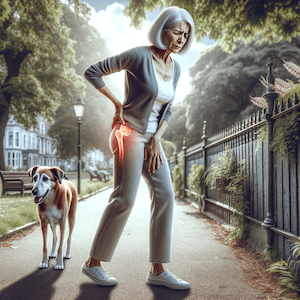Greater Trochanteric Pain Syndrome (GTPS)
Article by Zoe Russell

Greater Trochanteric Pain Syndrome (GTPS)
Understanding and Managing Lateral Hip Pain
Introduction to Greater Trochanteric Pain Syndrome (GTPS)
Greater Trochanteric Pain Syndrome (GTPS) primarily affects the tendons and bursae near the greater trochanter, a prominent part of the femur on the hip’s side. This condition causes pain outside the buttock and thigh. GTPS includes gluteal tendon injuries and hip bursitis. The gluteus medius and minimus muscles’ tendons play a significant role in this syndrome. Tendinopathy, a result of excessive tendon load, is a common manifestation.
Common Causes of GTPS
GTPS can stem from direct trauma, prolonged hip pressure, repetitive movements like walking or running, inadequate exercise preparation, sustained weight-bearing on one leg, hip instability, or sporting injuries.
Identifying GTPS Symptoms
Symptoms include pain over the greater trochanter, possibly extending to the lateral thigh or leg. A notable ‘jump’ sign is evident when palpating the greater trochanter. Pain typically worsens over time and is exacerbated by sleeping on the affected side or weight-bearing activities.
Diagnosis Process
A physiotherapist or doctor will conduct an examination to distinguish GTPS from other conditions. Diagnostic imaging, like ultrasound or MRI, may be used for confirmation.
GTPS-Related Injuries
Consulting a physiotherapist is crucial for an accurate diagnosis.

Effective Treatment Strategies for GTPS
Treatment focuses on pain management, enhancing hip strength and control, and a gradual return to sports. Physiotherapy plays a pivotal role, divided into three phases:
- PHASE I – Pain Relief & Protection: Managing pain through ice therapy, rest, and exercises. Techniques include ice, electrotherapy, acupuncture, taping, massage, and mobility aids.
- PHASE II – Restoring Normal Range of Motion (ROM) & Strength: After reducing pain and inflammation, the focus shifts to restoring hip joint ROM, muscle length, and tension. This phase includes strengthening, endurance, proprioception, balance exercises, and gait retraining, along with a tailored “Hip Core Stabilisation Program.”
- PHASE III – Restoring Full Function: Customised rehabilitation based on personal goals, focusing on a gradual return to desired activities. Ongoing hip stabilisation exercises are crucial to prevent recurrence.
Guidelines for Returning to Sport Post-GTPS
When returning to sport, it’s important to:
- Get clearance from your physiotherapist.
- Start below previous activity levels.
- Warm-up before exercise and apply ice afterward.
- Continue hip stabilisation exercises.
- Consult your physiotherapist if symptoms reappear.
Conclusion and Next Steps
GTPS, a condition impacting the hip’s tendons and bursae, requires a comprehensive treatment approach. A physiotherapist plays a critical role in diagnosing, treating, and guiding patients through recovery. Remember, patience is key in the healing process, and rushing can cause further damage. For personalised advice and effective management of lateral hip pain, it’s imperative to seek professional advice from a physiotherapist.
Recent Research Update:
New research emphasises the importance of individualised physiotherapy programs, particularly those focusing on strength and stability exercises for hip and core muscles, to effectively manage and prevent GTPS.
If you’re experiencing symptoms of GTPS or have concerns about hip pain, don’t hesitate to consult a physiotherapist for professional guidance and a tailored treatment plan.
Rochedale - Call 38410277
Book Online: RochedaleSalisbury - Call 32751044
Book Online: SalisburySandgate - Call 32691122
Book Online: SandgateRelated Articles
- Trochanteric Bursitis – Hip Bursitis: Causes & Treatments: Offers insights into the causes and treatment options for hip bursitis, a condition closely related to GTPS.
- Gluteal Tendinopathy: Causes, Symptoms, And Treatment: Discusses the symptoms, causes, and treatment of gluteal tendinopathy, which is often associated with GTPS.
- Piriformis Syndrome – Understanding & Physio Treatment Tips: Provides information on managing Piriformis Syndrome, which can be relevant for those experiencing similar hip and buttock pain as seen in GTPS.
- Sacroiliac Joint Dysfunction (SIJ) Causes, Relief, Treatment: Explores SIJ dysfunction, offering additional context on lower back and hip pain that might be mistaken for or contribute to GTPS.
- Hip Flexor: Iliopsoas Groin Pain: Causes And Treatment: Covers causes and treatments for hip flexor and groin pain, which could be useful for readers seeking a broader understanding of hip-related issues.































































